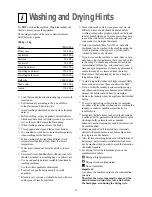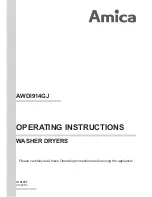
15
Washing and Drying Hints
i
Do NOT overload the machine. Weigh the laundry the
first few times you use the appliance.
The average weights of the most common items are
listed below as a guide:
1000g = 1 kg
Sheet 700-1000
g
Pillow case
100-200 g
Tablecloth 400-500
g
Serviette 50-100
g
Tea towel
70-120 g
Linen hand towel
100-150 g
Towelling hand towel
150-250 g
Towelling bath towel
700-1000 g
Bath robe
1000-1500 g
Man’s shirt
200-300 g
Apron 150-200
g
■
Load the laundry loosely alternating large items with
small ones.
■
Sort the laundry according to the type of fabric,
colour-fastness and how dirty it is.
■
Avoid washing unhemmed or torn items as they may
unravel.
■
Before washing, empty all pockets of small objects
which may have been left inside (coins, keys, screws
etc). as these could damage the drain pump.
■
When washing curtains, remove the hooks.
■
Close poppers and zips and fasten loose buttons.
■
It is essential to wash new coloured items separately
when washing for the first time.
■
When washing fabrics requiring different wash
temperatures together, always select the lowest
temperature.
■
White items should not be washed with coloured
items.
■
Very small items (handkerchiefs, ribbons, socks etc)
should be washed in a washing bag or a pillow case.
■
Use a good quality detergent suitable for automatic
washing machines.
■
Use the correct quantities of detergent.
■
For wool, use gentle detergent only in small
quantities.
■
Bleach is very corrosive; it should be used with care
and kept out of reach of children.
■
Some stains such as fruit, wine, grass, rust etc. are
difficult to remove and should be treated before
washing with specific products, which can be found
in most household shops. In some cases it may help
to soak the stain before washing with a special pre-
soak product or biological detergent.
■
Only wool marked “Pure New Wool - washable,
preshrunk” can be washed in the machine using the
wool programme; other types of wool should be
washed by hand or dry cleaned.
■
If you have used the machine to wash, rinse or spin
only non-colour fast garments, there may be dye left
in the sump. To ensure any subsequent wash is not
contaminated with the dye, select and carry out a
rinse and spin programme, without any garments, to
ensure that any dye is removed from the sump.
■
Do not leave the damp laundry load in a heap too
long before drying.
■
Avoid drying dark clothes with light coloured fluffy
items such as towels as these can attract the fluff.
■
If you overdry the laundry, besides wasting energy,
any subsequent ironing may become more difficult
because the fabric could be heavily crumpled.
■
Remove the laundry when the appliance has finished
drying.
■
To avoid a static charge when drying is completed,
use either a fabric softener when you are washing the
laundry or a fabric conditioner specifically for
tumble dryers.
■
Particularly delicate items such as synthetic curtains,
woollen and silk, garments with metal inserts, nylon
stockings, bulky garments such as anoraks,
bedcovers, quilts, sleeping bags and duvets must not
be machine dried.
■
Garments padded with foam-rubber or materials
similar to foam-rubber must not be machine dried;
they represent a fire hazard.
■
Also, fabrics containing residues of setting lotions or
hair sprays, nail solvents or similar solutions must
not be machine dried in order to avoid the formation
of harmful vapours.
■
For drying, follow the indications given on the
manufacturer’s labels.
Drying at high temperature
Drying at reduced temperature
Do not tumble dry
Important:
As a dryer, the machine works on the condensation
principle.
Therefore, the water taps must be open and the
drain hose must drain water into a sink or into
the drain pipe, even during the drying cycle.
Summary of Contents for WDS 1183 W
Page 31: ...Z ...
















































